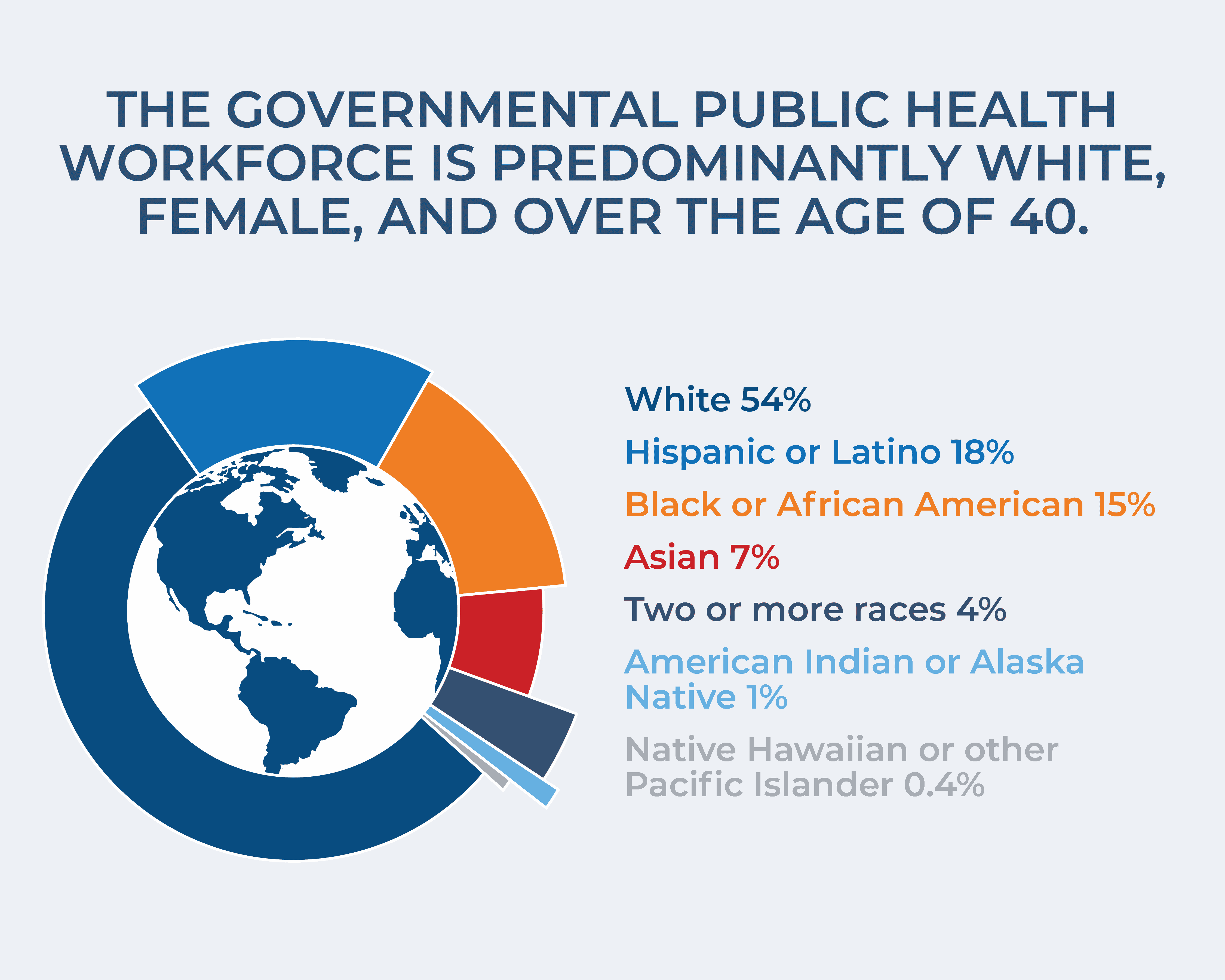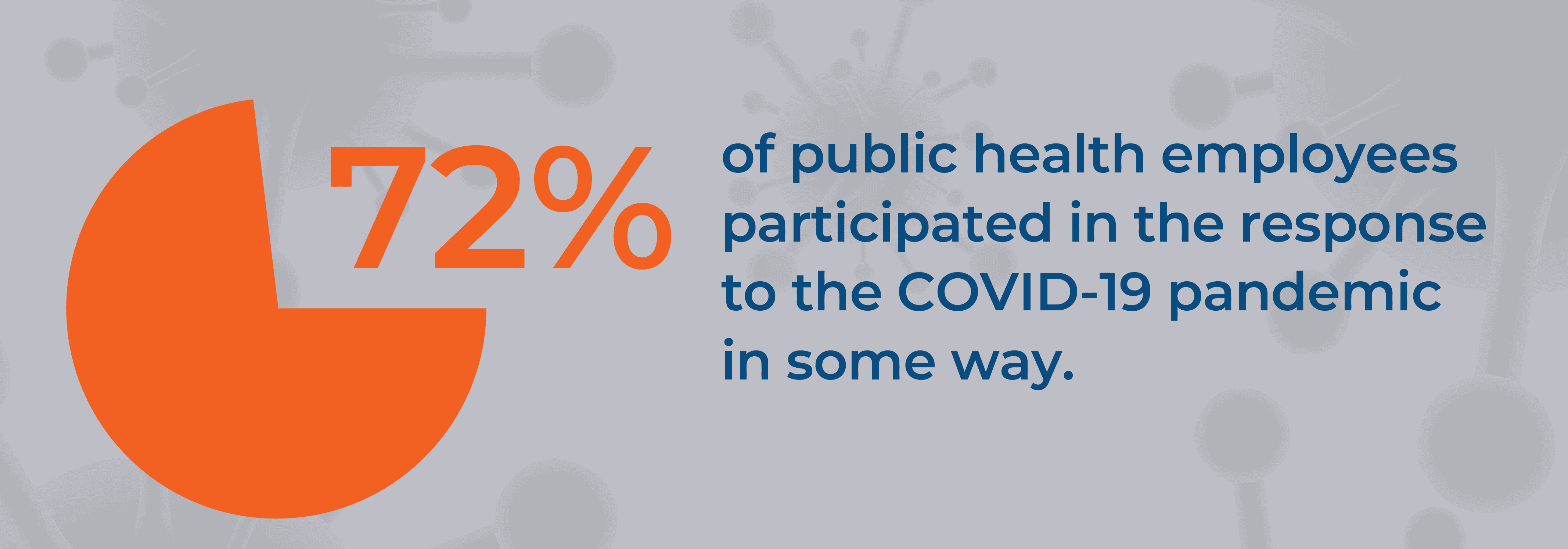Findings from the 2021 Public Health Workforce Interests and Needs Survey (PH WINS) provide a unique snapshot of the state and local government public health workforce, including demographics, job characteristics, training needs, intent to stay or leave, professional engagement and satisfaction, and overall well-being of employees. The data, from a survey of nearly 45,000 employees at all levels, were released today along with interactive dashboards that allow users to explore the data by age, gender, race/ethnicity, professional level, type of health department, and other factors.
The PH WINS survey was conducted by the de Beaumont Foundation and the Association of State and Territorial Health Officials (ASTHO) between September 2021 and January 2022. Previously conducted in 2014 and 2017, PH WINS is the only nationally representative survey of state and local government public health employees. Preliminary survey findings released in March 2022 revealed high levels of stress, burnout, and intent to leave, and were detailed in a research brief, “The Impact of the COVID-19 Pandemic: Rising Stress and Burnout in Public Health.”
“The public health workforce brings so much of themselves to their jobs, with more than nine in ten saying they are determined to give their best effort at work every day – a number that is all the more remarkable given the challenges they have faced in the last two years,” said Michael R. Fraser, PhD, MS, chief executive officer of ASTHO. “Their continued effectiveness and dedication are vital to our nation’s health, and data like this help state and local health department leaders determine how they can best support their teams and communities.”
Brian C. Castrucci, DrPH, president and CEO of the de Beaumont Foundation, said, “When people leave the workforce, we lose talent and experience that are crucial as we prepare for future public health crises. Without them, the public is at greater risk. Retaining the experts we have, investing in public health infrastructure, and staffing up state and local health departments to provide essential services are critical to meeting our current and future public health needs.”
The new data show trends from surveys in previous years and new insights about the workforce.
Demographics

When considering age, the majority of the workforce remains over 40, but there were significant increases in the proportion of employees between 31 and 40 and between 21 and 30, with more than one in eight (13%) in the youngest group. Overall, the workforce is becoming younger, with an average age of 46, compared with 47 in 2017 and 48 in 2014.
Learn More:
- Meet the changemakers: de Beaumont’s 40 Under 40 in Public Health
- Report by the Center for State and Local Government Excellence: How Does the Public Health Workforce Compare with the Broader Public Sector?
- Blog post: “Why Public Health Needs Gen Z”
Job roles
Nearly three in four public health employees (72%) participated in the response to the COVID-19 pandemic in some way. Relative to 2017, the proportion of employees working in communicable disease increased three-fold, rising from 8% to 24%, and the portion working in nearly all other job categories decreased. Among the areas where staffing decreased the most were organizational competencies, environmental health, and communications, from 24% to 18%, 13% to 9%, and 4% to 1%, respectively. [Note: this data in this paragraph was updated on November 1, 2022.]
Learn More:
- See the updated 10 Essential Public Health Services
- Report by the de Beaumont Foundation and the Public Health National Center for Innovations: Staffing Up: Investing to Improve Public Health Services and Protections
Intent to leave
Nearly one-third of state and local public health employees (32%) said they are considering leaving their organization in the next year – 5% to retire and 27% for another reason. Among those who said they’re considering leaving, 39% said the pandemic has made them more likely to leave. Looking out further, 44% said they are considering leaving within the next five years, and of those, 30% said the pandemic has made them more likely to leave.
Learn More:
- PH WINS 2021 Findings: The Impact of the COVID-19 Pandemic: Rising Stress and Burnout in Public Health
- Report by the de Beaumont Foundation and the Public Health National Center for Innovations: Staffing Up: Investing to Improve Public Health Services and Protections
Training needs
Across seniority levels, budgeting and financial management are top areas of high day-to-day importance but low proficiency among public health professionals, with 54% of employees reporting a need for greater training in this area. Policy engagement and topics related to justice, equity, diversity, and inclusion were also identified as important areas of needed training, especially by senior staff and executives. Among executives, these areas ranked just behind Budget & Financial Management and Systems & Strategic Thinking in self-reported training needs.
Learn More:
- March 2021 report: Adapting and Aligning Public Health Strategic Skills
- Training: BEAM certificate: Business skills for public health professionals
The PH WINS 2021 survey was distributed to nearly 138,000 state and local governmental public health employees, representing 47 state health agencies, 29 big city agencies, and 259 local health departments. It was completed by 44,732 individuals, for a 32.5% response rate, and additional data releases and analyses are anticipated in the coming months. For more information, visit www.phwins.org.





